Flat roofs are a popular choice for many buildings, as they offer a simple, economical alternative to traditional pitched roofs. These roof types can be installed quickly and easily, and often provide a good amount of usable space on the roof itself. But before you decide to go with a flat roof, there are some important considerations to keep in mind.
Disclaimer: This article is intended to provide general information about flat roof systems. It should not be considered as professional advice and should not replace consultation with a qualified roofing contractor. Before making any decisions regarding your flat roof, we highly recommend that you get in touch with a local expert for further guidance and advice. For quality, experienced roofing services tailored to your specific needs, please contact Advance Roofing LLC at https://advanceroofingllc.com/ – We are always happy to help! With years of experience providing the Spokane, WA area with top-notch roofing solutions and customer service you can rely on, Advance Roofing LLC is proud to offer the highest standard of quality when it comes to flat roofs.
What is a Flat Roof?
A flat roof is a type of roof that features a horizontal or nearly horizontal surface. Unlike sloped roofs that have a pitch to drain off water, flat roofs are designed to be water resistant and have a low slope to allow for proper drainage. Flat roofs are popular for commercial buildings, but can also be found on residential properties. In this article, we will cover everything you need to know about flat roofs, including the best roofing materials, the benefits of roof coatings for flat roofs, and common problems to watch out for.
Benefits of Flat Roofs

Flat roofs are becoming increasingly popular among homeowners and commercial building owners because of their many benefits. In this article, we will take a closer look at the advantages of having a flat roof.
Cost-Effective
One of the most significant benefits of a flat roof is its cost-effectiveness compared to other roofing styles. Flat roofs require less material for construction, which makes them less expensive to install. Flat roofs also require less maintenance and repair work over time, which means lower expenses in the long run.
Versatility
Flat roofs are highly versatile and can be used for various purposes. They are ideal for creating additional usable space for outdoor entertainment or storage. They are also suitable for rooftop gardens that can provide environmental benefits like reducing heat islands and improving air quality in urban areas.
Energy-Efficient
In warmer climates, flat roofs offer significant energy savings because they reflect solar radiation away from the building rather than absorbing it like traditional sloped roofs. The reflective coating used in flat roofs can also help to keep utility costs manageable, especially during the hot summer months.
Low Maintenance
Flat roofs require substantially less maintenance than sloped roofs, as they do not have shingles or tiles that can break or fall off. This reduced maintenance translates to lower costs over the life of the roof. Additionally, flat roofs have fewer seams and joints, which reduces the likelihood of water damage and leaks.
Durability
Flat roofs are built to be strong and durable. They have a long track record of performing well in harsh weather conditions, from heavy snow to powerful winds. Flat roofs are particularly suitable for commercial buildings because they can accommodate large HVAC systems and other equipment while still maintaining their integrity as a roofing system.
In conclusion, the benefits of flat roofs are numerous and varied, making them a popular choice for building owners. They are cost-effective, versatile, energy-efficient, low maintenance, and durable. These factors make them a practical and reliable option for construction and renovation projects.
Common Types of Flat Roofs

Flat roofs have become increasingly popular due to their affordability, versatility, and energy efficiency. Flat roofs are available in several types, each with its unique characteristics. In this article, we will discuss some of the common types of flat roofs available on the market.
Built-Up Roofing (BUR)
Built-up roofing is one of the most traditional types of flat roofs. It is made up of multiple layers of tar and gravel, which provides excellent durability and protection against the elements. The gravel layer also reflects sunlight, which contributes to the efficiency of the roofing system. However, the installation of BUR is a labor-intensive and time-consuming process, and the roofing material is quite heavy, which might cause structural issues.
PVC Membranes
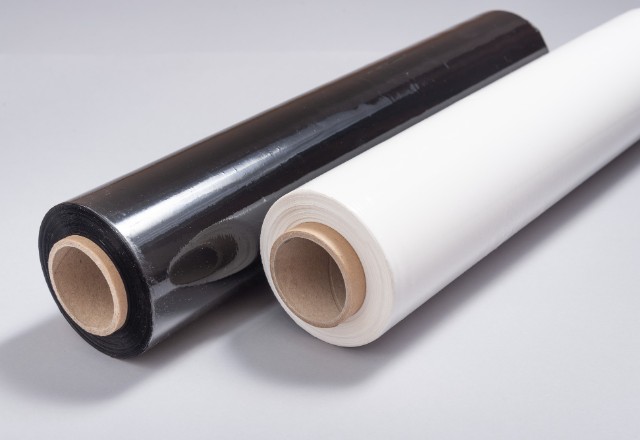
PVC (polyvinyl chloride) membranes are becoming increasingly popular as a flat roofing solution due to their durability, longevity, and weather resistance. They are also lightweight, making them easier to install compared to other flat roofing materials. Additionally, PVC membranes are available in a variety of colors to suit different aesthetic preferences. However, they can be relatively more expensive than other flat roofing options.
Modified Bitumen
Modified bitumen is another popular option for flat roofs. This type of roofing material consists of bitumen (asphalt or coal tar) reinforced with synthetic fabrics or fibers. This combination provides excellent durability and resistance to harsh weather conditions. Modified bitumen roofs are also easy to install and maintain. However, they might not be suitable for buildings located in colder climates as they can become brittle.
Rubber Membrane
Rubber membranes, also known as EPDM (ethylene propylene diene terpolymer) roofing, are a popular option for commercial and residential flat roofs. They are highly durable and resistant to water, impact, and UV rays. Rubber membranes are also an affordable roofing option and easy to install. However, they can be vulnerable to punctures, which could lead to leaks.
Thermoplastic Membrane
Thermoplastic membranes, known as TPO (thermoplastic polyolefin) roofing, are a newer option on the market and quickly gaining popularity. This type of roofing material is a blend of rubber and plastic polymers that provide great flexibility and resistance to UV rays. They are relatively affordable, energy-efficient, and low-maintenance. However, they might not be appropriate for buildings located in cold climates as they can become brittle over time.
Choosing a suitable flat roof system for a building involves considering various factors such as budget, climate, durability, and maintenance needs. Each type of flat roof has its unique characteristics and benefits, and it is advisable to consult with a professional roofing contractor to determine the best option for a specific building.
Maintenance and Repair
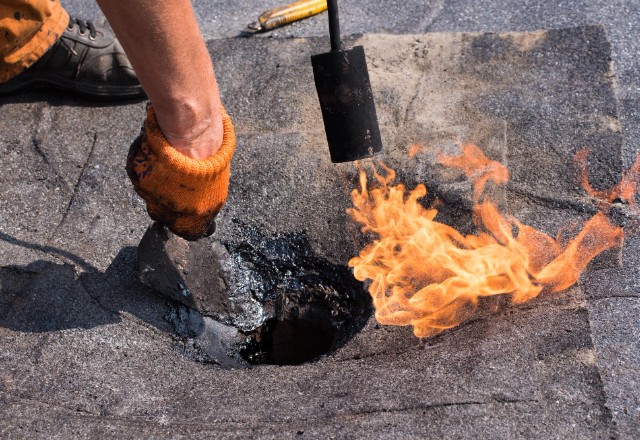
Maintenance and Repair are essential components of ensuring the longevity and durability of your flat roof. Regular maintenance can help prolong its lifespan and prevent costly damages, while prompt repairs can prevent further damage and help avoid complete roof replacement. In this article, we will discuss everything you need to know about maintaining and repairing flat roofs, including common issues, prevention tips, and repair solutions.
Regular Inspection and Maintenance
Flat roofs are commonly found in commercial buildings, and it is essential to ensure their regular inspection and maintenance. Regular inspections are critical to detect any issues early on and avoid costly repairs or replacement. Therefore, it is recommended to inspect your flat roof at least twice a year.
- During inspections, the primary purpose is to check for signs of wear and tear, water damage, and cracks. The weather regularly affects flat roofs, making them vulnerable to cracks, leaks, and other issues. Water damage is one of the most significant problems as it can result in severe structural damage if not addressed immediately.
- Clearing debris from roof surfaces is also critical to prevent blockages and ensure that drainage systems are functioning correctly. Blocked drainage systems can cause water to accumulate, leading to ponding water, which can also result in roof damage. Therefore, it is essential to ensure that drainage systems are clean and unclogged to prevent water from pooling on the roof, causing further damage.
- Apart from the above, it is vital to inspect flashing and joints around penetrations for signs of damage, such as rust or corrosion. Flashing is an essential component that helps prevent water from seeping into the roof. Any damage to it can cause water to leak into the roof, leading to water damage and other severe issues.
Regular inspections and maintenance of flat roofs are an essential aspect of ensuring their longevity and preventing costly repairs or replacements. It is recommended to inspect flat roofs at least twice a year and check for signs of wear and tear, water damage, and cracks. Additionally, regular clearing of debris and ensuring proper functioning of drainage systems are critical to prevent water accumulation on the roof. Finally, inspecting flashing and joints around penetrations to address any damage helps prevent water from causing further damage.
Dealing with Ponding Water
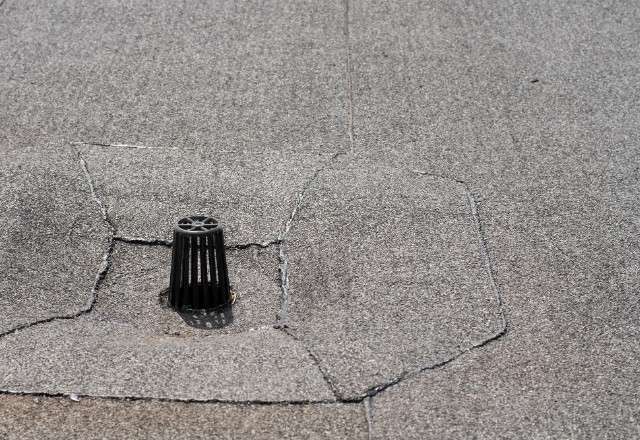
Ponding water on a flat roof can lead to serious damage if not promptly addressed. Therefore, it is essential to deal with ponding water to maintain your roof’s structural integrity. Here are some tips:
- Ensure Proper Drainage: To prevent heavy ponding water, it is crucial to construct your flat roof with proper drainage. Ensure that your roof has a slight slope to facilitate water flow towards the drains.
- Inspect Your Commercial Roof Regularly: It is essential to inspect your flat roof after a major weather event to identify any punctures or tears in the roof that may cause ponding water. Regular inspections of the drainage system can help prevent ponding water.
- Install Walkways: One of the main causes of ponding water is foot traffic. To avoid this, install proper walkways to prevent people from walking on your roof.
- Use Ponding Water Roof Coatings: Applying ponding water roof coatings can prevent sagging or leaking and help to maintain your roof’s structural integrity. The coatings have a waterproof seal that prevents water from penetrating into the roof.
- Use Heavy-Duty Rollers: When applying the ponding water coating, use heavy-duty 18″ rollers or a sprayer that has never been used with water-based products to ensure proper coverage.
In conclusion, dealing with ponding water on a flat roof requires proactive measures such as proper roof drainage, regular inspections, installation of walkways, and applying ponding water coatings. These measures will prevent water damage and ensure the longevity of your flat roof.
Identifying Weather-Related Damage
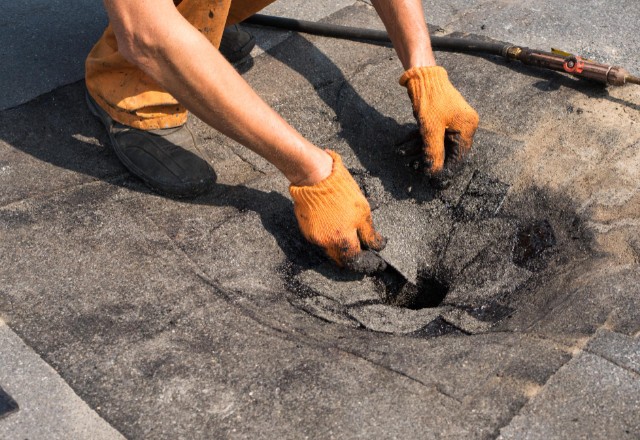
Flat roofs are common in commercial buildings, and they are known for their long lifespan when properly installed and maintained. However, extreme weather conditions can take a toll on flat roofs, leading to damage that may be costly to repair. Therefore, it’s essential to identify weather-related damage to your flat roof early and take the necessary measures to fix it. Here are some tips on how to identify weather-related damage to flat roofs:
- Look for signs of exposure to extreme temperatures: Flat roofs are known to expand and contract due to temperature fluctuations, and this can cause damage over time. Look for cracks on the roof surface or interior walls, which may indicate damage caused by expansion and contraction.
- Check for signs of UV damage: Flat roofs are particularly susceptible to damage from UV rays, especially in hot climates. Look for bubbling or bowing of interior walls, which may indicate that the roof’s membrane has been damaged by exposure to UV radiation.
- Look for water stains on the surface of the roof: Prolonged exposure to heavy rainfall can cause water to seep through the roof’s membrane, leading to water stains on the roof’s surface. You may also notice pooling water on the roof’s surface, which may indicate that the roof has sagged due to water damage.
- Examine the roof membrane for hail damage: Hailstorms can cause significant damage to flat roofs, and it’s essential to examine the roof’s membrane for signs of tearing or puncturing. Hail damage can compromise the waterproofing of your flat roof, leading to roof leaks and other issues.
- Schedule regular flat roof inspections: To identify weather-related damage early, it’s crucial to schedule regular flat roof inspections with a professional roofing contractor. During these inspections, a contractor can identify any damage and recommend the appropriate repairs or replacement.
When scheduling repairs for weather-related damage to a flat roof, it’s crucial to choose a coating that is specifically designed to withstand the conditions of your local environment. Some roofing materials are better suited for cold climates, while others are better for hot and humid climates. By identifying the specific weather-related damage to your flat roof and using the appropriate coating materials during repairs, you can extend the lifespan of your flat roof and prevent costly damage down the line.
Repairs for Flat Roofs

When it comes to repairing a flat roof, the extent of the damage and the type of roof will determine the best course of action. Some repairs may only require simple fixes, while more significant damage may require a complete replacement of the roof. Here are some common repair options for flat roofs:
-
Patching
Patching is a straightforward and cost-effective way to repair small punctures or cracks on your flat roof. A flat roof repair kit may include the necessary materials for patching such as roofing cement, mesh fabric, and a putty knife. Be sure to clean and dry the damaged area before applying the patch. It’s important to note that patching may only be a temporary solution and may not be suitable for larger damages.
-
Coatings
Roof coatings are often used as a maintenance solution for flat roofs to increase their lifespan. Coatings, such as elastomeric or silicone roof coatings, function as a barrier against moisture and UV rays, which are two of the primary causes of damage for flat roofs. Roof coatings are best used on roofs that do not have significant damage and can be a cost-effective way of preventing further damage.
-
Membrane Replacement
If your flat roof has significant damage, or water is penetrating through the roof membrane, it may need to be replaced. This type of repair involves removing old and damaged membrane layers and replacing them with new ones. It is essential to have a professional roofing contractor perform this type of repair, as it requires careful installation and handling of roofing materials. A membrane replacement can be expensive, but it will provide a long-lasting solution to your roof problem.
Detecting Leaks and Identifying Weak Spots
A crucial aspect of flat roof repairs is detecting leaks and identifying weak spots in the roof’s structure. A leak in a flat roof can be difficult to detect because water can travel several feet away from the actual point of entry. A professional contractor can accurately identify the location of the leak by checking for water stains, pooling water, or moisture buildup in the roof’s insulation. Identifying weak spots in the roof’s structure is also important since flat roofs are known to have sagging or uneven areas. A professional contractor can inspect the roof for any structural damage that may need to be addressed before repairing the roof.
Key Components of the Repair Process
The materials needed for repairing a flat roof may vary depending on the extent of the damage. It’s crucial to use the appropriate roofing materials to ensure long-lasting repairs. Common materials used for repairing flat roofs may include roofing cement, flashing, sealant tape, and custom-cut membrane pieces. It’s essential to adhere to local building codes when attempting to repair a flat roof to ensure that the work is up to code and safe for occupants.
In conclusion, repairing a flat roof can be challenging, but with the right knowledge and professional help, it can be done effectively. Simple fixes such as patching or coating can prevent further damage for minor problems, while more significant damage may require a membrane replacement. Identifying leaks and weak spots in the roof’s structure is critical in preventing future damages, and using appropriate materials and adhering to local building codes can ensure a long-lasting and safe repair job.
Materials Used in Flat Roofs
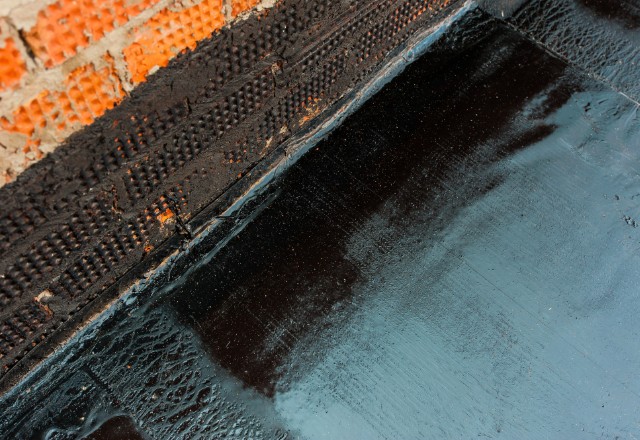
Flat roofs are an essential element in modern architecture, providing a sleek and minimalist look to buildings. To construct a flat roof, a unique set of materials is required to support its weight and provide adequate insulation. These materials must offer long lasting durability and weather resistance to protect the building and its occupants. In this article, we will explore the materials commonly used in flat roofs to help you make an informed decision when choosing one for your roofing project.
Built-Up Roofing (BUR)
Built-Up Roofing (BUR) systems have been around for over a century and are still widely used in commercial buildings. BUR systems typically consist of multiple layers of asphalt and fiberglass or polyester felts, also known as plies, which are then topped with a layer of gravel or a mineral surface. The layers are applied with hot asphalt, a process called hot-mopping, creating a thick and durable roofing system.
One of the main benefits of BUR systems is their durability. They have a long life expectancy of up to 30 years, and their multiple layers provide excellent protection against leaks, impacts, and weather damage. Additionally, the layers offer excellent insulation, making BUR roofs energy-efficient and reducing heating and cooling costs for businesses.
Despite its longevity and insulation benefits, BUR systems have some downsides. They can be heavy, which may not be suitable for all commercial buildings that require a specific load capacity. The hot-mopping process can also be messy, requiring a skilled roofing contractor to prevent any accidents or heat damage.
During the installation process, it is crucial to take necessary precautions, especially when laying down the layers with hot asphalt. The fumes from the hot-mopping process can be hazardous, and proper safety gear and ventilation must be used. Depending on the size of the commercial building, installation may take a considerable amount of time, which could cause inconvenience to businesses.
In conclusion, Built-up Roofing (BUR) systems are an excellent roofing option for commercial buildings due to their durability and insulation benefits. However, it is essential to consider the downsides and take necessary precautions during installation to guarantee the safety and efficiency of the roofing system.
Modified Bitumen Membrane Systems
Modified Bitumen Membrane Systems are a type of membrane roofing that is increasingly popular in the commercial roofing industry. These systems consist of reinforced layers of asphalt with modifiers added to the mix to improve their durability and resistance to weathering.
The modified bitumen roofing materials are usually sold in rolls and laid down using a heat-welding process, which creates a continuous, waterproof membrane over the roof surface. The installation process typically involves using adhesives or heat to seal the seams between the rolls, creating a strong, monolithic roof surface that is resistant to water and weather damage.
- One of the significant benefits of modified bitumen membrane roofing is their durability.
- They can withstand high temperatures and heavy foot traffic, making them ideal for commercial roofing applications.
- Additionally, they are weather-resistant and can handle harsh environmental conditions, including high winds and heavy rains.
- They also have excellent waterproofing ability, preventing leaks and moisture damage to the building’s interior.
Modified bitumen membrane roofing materials are commonly used in various commercial roofing applications, including low-slope roofs, flat roofs, and structures with varying angles and shapes. They are also versatile enough to work on various roofing systems, including metal roofs, concrete decks, and wood substrates.
In conclusion, Modified Bitumen Membrane Systems offer an excellent alternative to other commercial roofing materials. Their durability and weather-resistant properties make them ideal for harsh climates and high-traffic areas. They provide a long-lasting, low-cost, and low-maintenance roofing solution for commercial buildings, ensuring the safety and comfort of the premises they protect.
Thermoplastic Polyolefin (TPO) Membranes
Thermoplastic Polyolefin (TPO) Membranes are a type of single-ply white membrane that have become increasingly popular in commercial and residential roofing. These membranes are made of a blend of rubber, polypropylene, and filler materials that create a sturdy and durable roofing material.
One of the primary benefits of TPO membranes is their reflectivity. These white membranes reflect heat and solar radiation, reducing the amount of heat absorbed by the building. This can lead to significant energy savings and a more comfortable indoor environment. In addition, TPO membranes are resistant to substances such as oils and fats, making them ideal for commercial applications.
However, there are potential drawbacks to using white TPO membranes. They may be more prone to getting dirty and require more frequent cleaning than other roofing materials, such as EPDM. Additionally, TPO membranes may absorb heat in colder climates, which reduces their effectiveness in promoting energy efficiency.
To ensure that TPO membranes last up to 25 years, it is critical to have them properly installed by a qualified roofing contractor. Proper installation involves ensuring that the roof is clean, dry, and free of any debris that could damage the membrane. The contractor will also need to carefully seal the seams and edges to prevent leaks and maintain the membrane’s durability.
In conclusion, TPO membranes are an excellent roofing material for commercial and residential buildings. Their reflectivity and resistance to substances make them a popular choice, but proper installation is crucial to ensure their longevity and effectiveness. Consider choosing TPO membranes for your next roofing project to enjoy the many benefits they offer.
Elastomeric Coatings, Sealants and Adhesives

Flat roofs are a staple in the roofing industry, and they require unique protection and maintenance techniques to ensure they remain functional and long-lasting. Among the essential components of flat roof systems are elastomeric coatings, sealants, and adhesives.
Elastomeric coatings are crucial for flat roofs as they create a water-resistant barrier that protects the underlying roofing materials from UV rays and weather-related elements. These coatings are made from elastic and flexible materials that allow them to expand and contract depending on temperature and weather conditions. The coatings can also stretch to accommodate minor movements in the roof, minimizing the risk of cracking.
In addition to providing waterproofing protection for flat roofs, elastomeric coating also offers an attractive finish that can help reduce energy costs by reflecting solar radiation. The reflective coating can help prevent the roof from absorbing too much heat, which can cause the internal temperature to increase, leading to higher cooling costs.
Elastomeric sealants and adhesives are also commonly used in conjunction with elastomeric coatings to seal gaps in the roofing system. These materials protect the roof from water damage by preventing moisture from penetrating the roof’s interior. Elastomeric sealants are used to fill gaps caused by pipes, vents, and other roof penetrations, while elastomeric adhesives are used to bond roof seams together to create a continuous waterproof membrane.
When choosing an elastomeric coating for flat roofs, it’s crucial to consider the type of roof, the weather conditions, and the expected foot traffic. Some elastomeric coatings are better suited for low-sloped roofs, while others are designed for steep roofs. Additionally, some coatings are more durable in harsh weather conditions, while others are ideal for areas with high foot traffic.
In conclusion, elastomeric coatings, sealants, and adhesives are vital components of flat roof systems. They offer essential waterproofing protection, energy efficiency, and an attractive finish. When applied correctly by qualified roofing professionals, these materials can significantly extend the lifespan of flat roof systems while minimizing the risk of leaks, water damage, and other costly repairs.
Silicone Coating Systems
Silicone coating systems are popular for flat roofs due to their excellent water resistance, durability, and UV protection. These coatings are composed of a silicone-based formula that creates a protective barrier that can withstand harsh weather conditions and resist ponding water.
The benefits of using silicone coatings in comparison to other coating materials are numerous. For one, silicone coatings offer superior weather resistance and can withstand extreme temperatures without cracking or peeling. Their UV protection allows them to maintain their color and finish, even in direct sunlight. Unlike some other coatings, silicone coatings are also resistant to chemicals and can withstand foot traffic, making them a good choice for high-traffic areas.
One potential drawback of silicone coatings is their relatively high cost compared to other materials. Additionally, silicone coatings require a specialized application process and primer to ensure proper adhesion, which can increase the overall cost of the project.
To apply silicone coatings to a flat roof, proper surface preparation is essential. The roof must be cleaned thoroughly to remove any debris or contaminants, such as oil, grease, or dirt, that can interfere with the adhesion of the coating. Next, a primer must be applied to the roof surface to ensure adhesion and prevent the coating from peeling or cracking. After the primer has dried, the silicone coating can be applied in several coats until the desired thickness is achieved.
There are several different types of silicone coating systems available in the market. Some of the most common include moisture cured silicone coatings, solvent-based silicone coatings, and water-based silicone coatings. Moisture cured silicone coatings cure through exposure to atmospheric moisture and are generally the most durable option. Solvent-based coatings are typically used for more demanding applications and offer superior water resistance. Water-based coatings are eco-friendly and easy to apply but may not provide the same level of durability as other options.
Overall, silicone coating systems are an excellent choice for flat roofs due to their superior durability, UV protection, and water resistance. While they may be more expensive than some other materials, their longevity and performance make them a sound investment for those seeking long-term protection for their roofs. With proper surface preparation and application techniques, silicone coatings can provide a long lasting, attractive finish that will protect a flat roof for years to come.
Energy Efficiency of Flat Roofs

Flat roofs are gaining popularity due to their exceptional energy efficiency. One of the primary reasons for their energy efficiency is their reflective nature. Flat roofs are designed to reflect the sun’s UV rays rather than absorbing them, which significantly reduces the need for air conditioning to keep the building cool in hot weather. This feature alone can help save homeowners and commercial building owners a substantial amount of money on their annual energy bills.
Apart from their reflectivity, flat roofs are also energy-efficient because of their insulation. With proper insulation installed during the winter months, heat loss is significantly reduced, and warmth is retained inside the building. In the summer months, insulation installed on a flat roof can help keep cool air circulating and prevent the air conditioning from working too hard to maintain a comfortable temperature. This feature can also have a positive impact on energy bills.
Another key feature of flat roofs is their durability. Many flat roof systems are made with high-quality materials that can withstand a wide range of weather conditions and provide longevity to the roof’s lifespan. With a durable roof, homeowners and commercial building owners can avoid costly repairs and replacements, resulting in further energy savings in the long run.
In conclusion, flat roofs are an excellent option for those seeking energy efficiency. They offer a reflective nature, insulation, and durability, which provides homeowners or commercial building owners with both cost savings and peace of mind. With the right installation and maintenance, flat roofs can be a cost-effective option for years to come, reducing energy bills and improving overall energy efficiency.
Conclusion
Flat roofs are a great choice for those seeking energy efficiency and durability. With the correct installation and maintenance, they can provide homeowners or commercial building owners with cost savings, energy efficiency, and longevity. By coating them with silicone coatings, they can also be protected against UV rays and water damage, further increasing their lifespan. Ultimately, flat roofs offer an excellent solution to those looking to reduce energy costs while still enjoying the benefits of a functional roof system.
Regular maintenance and inspection, prompt repairs, and proper decision-making when it comes to restoring or replacing a flat roof are critical to maintain its longevity and energy efficiency while avoiding costly damages. Working with a trusted roofing contractor can provide peace of mind and help you achieve your goals.



 509-201-4190
509-201-4190
